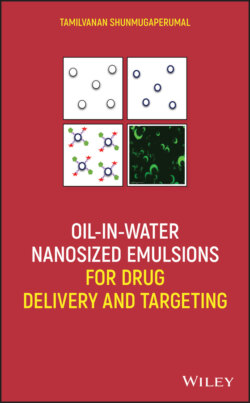Читать книгу Oil-in-Water Nanosized Emulsions for Drug Delivery and Targeting - Tamilvanan Shunmugaperumal - Страница 18
1.1.2. Nanosized Emulsions
ОглавлениеAn emulsion is a biphasic liquid preparation consisting of two immiscible liquids, one of which (the dispersed phase) is finely and uniformly dispersed as globules throughout the second phase (the continuous phase) (Barkat et al. 2011). If the amount of oil phase is significantly low when compared to the amount of water phase, then, the final emulsion is termed as oil‐in‐water (o/w) emulsion. Conversely, when the amount of water phase is significantly lower than the oil phase, the resulting emulsion system appears to be somewhat more viscous and is called as water‐in‐oil (w/o) emulsion. Both o/w and w/o type of emulsion systems are stabilized against the aggregation, coalescence and separation of dispersed oil or water phase by the addition of a third component called as emulsifying agent or emulgent or emulgator. In fact, the therapeutic emulsions are being stabilized by the addition of more than one emulgent molecules in order to prevent random collision of‐and then the coalescence of‐dispersed oil or water phase of the o/w or w/o emulsion. Mixing of appropriate amounts of oil, water and emulgent leads to the formation of an emulsion and this whole process is being named as emulsification. Apart from the amount of dispersed oil or water phase which will determine the type of final emulsion formed (whether o/w or w/o), the amount of single or multiple emulgent molecule added during the emulsification process will obviously control the type of emulsion produced. In addition, the size‐reduction equipments such as high‐energy or low‐energy homogenizer used to mix the oil and water phases along with single or multiple emulgent molecules will also direct the final emulsion produced in terms of mean size of the dispersed phase in the final emulsion. Interestingly, both high‐and low‐energy homogenizers will generate emulsions with nano‐range droplets particle sizes of the dispersed phase.
The emulsion generated by the low‐energy or spontaneous emulsification process is termed as microemulsion. On the other hand, the emulsion produced by means of the high‐energy homogenizers is called as nanoemulsion or nanosized emulsion. Again there are few basic differences between microemulsion and nanosized emulsion. Firstly, the microemulsion possesses the dispersed phase droplet diameter value well below the range of 100 nm, typically even below 10 nm as well. But the dispersed phase droplet diameter of the nanosized emulsion lies above 100 nm that too in between 300 to 500 nm level. Secondly, the notable difference between these two emulsions is being their physical appearances. While the microemulsion creates solution like transparent appearance, the nanosized emulsion looks like slightly bluish‐coloured white milk. Thirdly, a moderately higher amount of single or multiple emulgent molecules is used for producing the microemulsion when compared to the emulsifier molecules' amount which is being utilized to prepare the nanosized emulsion. Table 1.2 depicts the basic differences between microemulsion and o/w nanosized emulsion. In spite of these basic differences between microemulsion and o/w nanosized emulsion, these two terms (micro‐ and nano‐emulsions) are, however, used interchangeably in many medical and pharmaceutical literatures.
TABLE 1.2. Typical Differences Between Microemulsion and Oil‐in‐Water Nanosized Emulsion
| Microemulsion | Oil‐in‐Water Nanosized Emulsion |
|---|---|
| Emulsifier concentration is high, i.e., 30–40% | Emulsifier concentration is comparatively less, preferably 2–5% and can be increased up to 10% |
| It is a thermodynamically stable isotropic mixture | It is thermodynamically unstable but kinetically stable for some time with the help of emulsifier molecule's coverage onto the dispersed oil droplet surface |
| Particle size ranges below 10 nm or below 100 nm | Particle size ranges from 200 to 700 nm |
| It is toxic for parenteral application but oral dosage form is possible. Any water‐soluble API can be used | All routes of application are possible |
